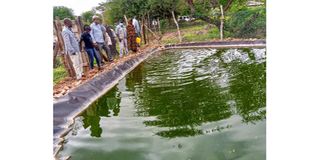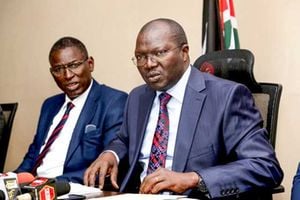Fish farming a game changer for women in arid Isiolo

Malka Bisanadi Cultural Village Group chairperson Makai Ntalu (with yellow jerrycan) with local leaders and government officials at the group’s fish pond in Kinna, Isiolo County, on January 13, 2022.
What you need to know:
- The persistent drought witnessed in Northern Kenya threatens pastoralism, which is the region’s economic mainstay.
- Group received 1,200 tilapia and 400 catfish monosex fingerlings from WFP.
- Fishes are ready for harvest from six to nine months.
As counties in arid and semi-arid lands contend with unpredictable weather patterns, residents are slowly diversifying into fish farming to expand their sources of income and build resilience.
The persistent drought witnessed in Northern Kenya threatens pastoralism, which is the region’s economic mainstay, with pastoralists seeking other alternatives to cushion themselves against losses including death of their livestock due to depletion of pastures and drying of water sources.
This, coupled with cattle rustling and crop failure due to inadequate rainfall, continues to condemn pastoralists to a lot of suffering rendering them food-insecure.
Fish farming is increasingly becoming a popular option in Kinna, Isiolo County, as they seek to beat perennial climatic shocks.
Fishes are ready for harvest from six to nine months.
Life-changing training
Malka Bisanadi Cultural village, a group of 25 women, is among those that recently ventured into aquaculture after receiving training at Sagana Fish farm in Kirinyaga County. Among the areas they studied include, fish nutrition, entrepreneurship and record keeping.
The group, which initially ventured into hotel business for members’ economic empowerment, is also producing orange fleshed sweet potato vines and tubers that are rich in beta carotene and Vitamin A, which are essential for growing children and pregnant women. The vines were donated by the World Food Programme (WFP) in partnership with the county government.
Chairperson Makai Mamo, says the potatoes have helped address malnutrition in the region as most residents can now afford nutritious foods for their children.
Water from nearby River Bisanadi has sustained their small-scale crop farming together with their 16 potato vine nurseries.
Being among the organised groups in the ward, the members from Borana community, also benefited from 1,200 tilapia and 400 catfish monosex fingerlings donated by WFP. They will be ready for harvesting from March.
The organisation provided them with polythene liners and water pipes for setting up the sunken ponds to accommodate the fishes as the women undertook the construction and fenced to protect them from predators such as birds.
“We also got extension support and were taught how to change the water, as well as feeding, which we had learnt in Sagana,” says Ms Mamo, adding that they have been feeding them on chicken growers mash and fish meal.
Isiolo is suitable for warm water fishes such as Nile tilapia and African Catfish that thrive well in dry conditions with temperature range between 27 and 30 degrees Celsius.
Rising demand for fish
The WFP associate officer in Isiolo, Irene Opwora, says the organisation has supported several groups in Kinna Ward to venture into aquaculture, apiculture and OFSP farming for economic empowerment and to eradicate hunger.
Besides the soaring demand for fish in the region and neighbouring Meru County, it is the returns that excited the group the most.
A kilogramme of fish is locally sold at Sh800, offering hope of raking thousands from the venture in their journey towards financial freedom.
“The venture offers a viable opportunity as one is likely to earn a lot of money within a short period of time different from crop and livestock farming,” she said during a recent interview with the Voice.
While fish consumption in the region is still lower than in the coastal and western regions of the country, the group is committed to continuously educating the public on the nutritional value of the food.
The average per-capita fish consumption in Kenya is 3.7 kilogrammes per year against the global average rate of 20 kilogrammes.
Isiolo County Director of Fisheries Felix Muthomi, says haven ponds should be refilled because of high rate of evaporation but pond liners can stay for up to six months without being recharged.
“Only 40 per cent of the water in the ponds should be drained,” Mr Muthomi says, adding that lime and Magadi soda can be used to disinfect and increase salinity.
He recommends high density polythene liners for best puncture resistance.
The women cite costly feed and poor breeding local stocks as their biggest drawbacks.
“We want to buy more fingerlings as those in the ponds are almost mature for harvesting, but there are no local suppliers of quality fish species,” the group leader says.
They ow appeal to Governor Mohamed Kuti’s administration to offer them subsidised feed for increased productivity.
The women term aquaculture as the solution to the changing climatic patterns, crop failure and livestock deaths, saying it will also contribute to food security, job creation and increased income.





